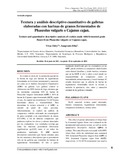| dc.rights.license | http://creativecommons.org/licenses/by-nc-sa/3.0/ve/ | es_VE |
| dc.contributor.author | Vivas, Odry | |
| dc.contributor.author | Sangronis, Elba | |
| dc.date.accessioned | 2021-12-07T13:53:17Z | |
| dc.date.available | 2021-12-07T13:53:17Z | |
| dc.date.issued | 2021-12-07 | |
| dc.identifier.issn | 2244-8845 | |
| dc.identifier.uri | http://www.saber.ula.ve/handle/123456789/47727 | |
| dc.description.abstract | Se evaluó el efecto de la sustitución parcial de la harina de trigo por harinas de leguminosas
fermentadas en la textura instrumental y sensorial, así como en el Análisis Descriptivo Cuantitativo
(ADC) en galletas. Las galletas control se elaboraron con 100% harina de trigo, mientras que las
sustituidas contenían 30% de harina de Phaseolus vulgaris fermentada (GPF) o 30% de harina de
Cajanus cajan fermentada (GCF), según el caso. Se empleó un texturómetro TA-XT2i para determinar
dureza y fracturabilidad. Para determinar la textura sensorial y el ADC, se entrenó un panel de
cinco personas. Adicionalmente, se realizó un análisis de compuestos volátiles utilizando un
cromatógrafo de gases acoplado a un espectrómetro de masas (CG-EM), a fin de detectar compuestos que
pudiesen explicar los olores y sabores detectados por los evaluadores. Los resultados revelan que
todas las muestras presentaron diferencias significativas (p<0,05) entre sí en todos los parámetros
analizados. El ADC mostró descriptores sensoriales que fueron comunes para las tres muestras y
descriptores que se presentaron sólo en las galletas que contenían las harinas de leguminosas
fermentadas. El olor a queso madurado identificado por los evaluadores en las GPF, puede atribuirse
a compuestos identificados como dimetil disulfuro y ácido butírico, mientras que en las GCF el olor
y sabor a miel puede ser responsabilidad de compuestos como el benzaldehído, a-butirolactona y 3-
metil-butanal. El estudio demostró que la adición de harina de leguminosas fermentadas afectó la
textura y también la apariencia, olor, sabor y sensación residual de las galletas evaluadas. | es_VE |
| dc.language.iso | es | es_VE |
| dc.publisher | SaberULA | es_VE |
| dc.rights | info:eu-repo/semantics/openAccess | es_VE |
| dc.subject | Perfil sensorial | es_VE |
| dc.subject | Textura | es_VE |
| dc.subject | Panel entrenado | es_VE |
| dc.subject | Harinas compuestas | es_VE |
| dc.subject | Leguminosas fermentadas | es_VE |
| dc.subject | Compuestos aromáticos | es_VE |
| dc.subject | Aroma | es_VE |
| dc.subject | Sabor | es_VE |
| dc.title | Textura y análisis descriptivo cuantitativo de galletas elaboradas con harinas de granos fermentados de Phaseolus vulgaris o Cajanus cajan | es_VE |
| dc.title.alternative | Texture and quantitative descriptive analysis of cookies made with fermented grain flours from Phaseolus vulgaris or Cajanus cajan | es_VE |
| dc.type | info:eu-repo/semantics/article | es_VE |
| dcterms.dateAccepted | 18/09/21 | |
| dcterms.dateSubmitted | 28/06/21 | |
| dc.description.abstract1 | The effect of partial substitution of wheat flour by fermented legume flours was evaluated on the
instrumental and sensory texture, as well as on the Quantitative Descriptive Analysis (QDA) in
cookies. The control biscuits were made with 100% wheat flour, while the substituted ones contained
30% fermented Phaseolus vulgaris flour (GPF) or 30% fermented Cajanus cajan flour (GCF),
respectively. A TA-XT2i texturometer was used to determine hardness and fracturability. To determine
the sensory texture and the QDA, a panel of five people was trained. Additionally, an analysis of
volatile compounds was carried out using a gas chromatograph coupled to a mass spectrometer (GC-MS),
in order to detect compounds that could explain the odors and flavors detected by the evaluators.
The results reveal that all the samples presented significant differences (p<0.05) among themselves
in all the parameters analyzed. QDA showed sensory descriptors that were common for the three
samples and descriptors that were presented only in the cookies containing the fermented legume
flours.
The smell of ripened cheese identified by the evaluators in GPF can be attributed to compounds
identified as dimethyl disulfide and butyric acid, while in GCF the smell and taste of honey can be
the responsibility of compounds such as benzaldehyde, a-butyrolactone and 3-methyl-butanal. The
study showed that addition of fermented legume flours affected the texture and also the appearance,
smell, taste and residual sensation of the cookies evaluated. | es_VE |
| dc.description.colacion | 8-17 | es_VE |
| dc.description.email | revfarm@ula.ve | es_VE |
| dc.description.email | odryvivas@gmail.com | es_VE |
| dc.description.frecuencia | Semestral | |
| dc.description.paginaweb | https://www.saber.ula.ve/farmacia/ | |
| dc.identifier.depositolegal | pp 1958 02 ME 1003 | |
| dc.identifier.edepositolegal | ppi201202ME4102 | |
| dc.publisher.pais | Venezuela | es_VE |
| dc.subject.institucion | Universidad de Los Andes | es_VE |
| dc.subject.keywords | Sensory profile | es_VE |
| dc.subject.keywords | Texture | es_VE |
| dc.subject.keywords | Trained panel | es_VE |
| dc.subject.keywords | Composite flours | es_VE |
| dc.subject.keywords | Fermented legumes | es_VE |
| dc.subject.keywords | Aromatic compounds | es_VE |
| dc.subject.keywords | Aroma | es_VE |
| dc.subject.keywords | Flavor | es_VE |
| dc.subject.seccion | Revista de la Facultad de Farmacia: Artículos | es_VE |
| dc.subject.thematiccategory | Medicina y Salud | es_VE |
| dc.subject.tipo | Artículos | es_VE |
| dc.type.media | Texto | es_VE |
| dc.identifier.doi | https://doi.org/10.53766/REFA/2021.63.02.02 | es |


